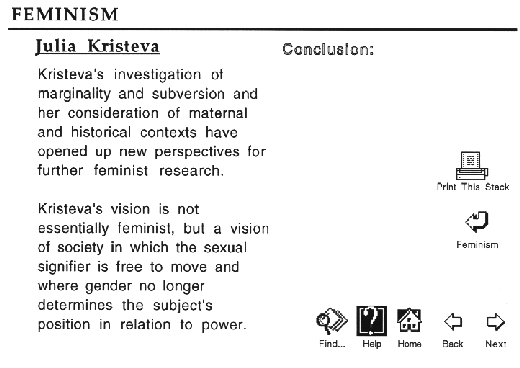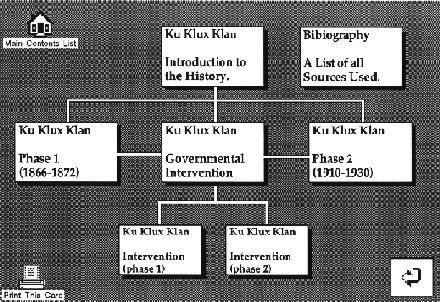 |
| Computers & Texts No.
11 | Table of Contents | March 1996 |
Deborah L. Madsen
Department of English
University of Leicester
Students studying American literature and culture at the University of Leicester are given the opportunity to construct their own hypertext stacks, encouraging interdisciplinary approaches to the subject and incorporating some of the theoretical aspects of hypertext. This article describes the course, the means by which it was assessed, and makes some observations about hypertext for literary and cultural studies.
Literature courses based around computing technology seem often to be text-based, in that students are required to annotate a text using hypertext (Stuart Moulthrop's Gravity's Rainbow stack at Baltimore) or to navigate a ready-made network of annotations to a specific text (the Isaac Rosenberg site at http://info.ox.ac.uk/departments/humanities/rose/).
I have designed a course that requires students to construct their own hypertext stacks from scratch - we begin with 'how to turn on the computer!' And the stacks represent some area within the field of contemporary critical theory rather than an individual text.
The design of the course derives from the source of funding. In 1992 I began developing a course for the Enterprise Learning Initiative at Leicester that would introduce 'transferable skills' as an essential component of literary study. (These transferable skills include computer literacy, time management, scheduling, group work and basic managerial skills.) This course was offered as 'Hypertext and Critical Theory' to final year English literature students - most of whom hoped that the inclusion of an IT-related course on their vita would bring some advantage in the job market. The course was so popular that a parallel course for American Studies students, 'Hypertext and Cultural Studies', was soon developed.
The aim of the course was twofold. From my point of view, I wanted to develop an electronic archive for critical theory and, as the contrasts between the two groups of students began to emerge, I wanted to investigate the power of hypertext to facilitate interdisciplinary study. From the point of view of the students, the course introduced them to the basics of computing (surprisingly, for many students this was their first hands-on experience of computing applications) within the context of data already at their disposal.
I chose, initially, to base the course around critical theory because all students of English at Leicester study a compulsory first-year course in critical theory. Students therefore had to master the techniques needed to represent this knowledge in hypertextual form, but they did not have to acquire the data (the substance) of the stacks they were to create. In a similar way, American Studies students take compulsory courses on 'The Wild West' and 'The American South' so these subjects provided the material for those stacks.
The course was workshop-based. We used Hypercard running on the campus Macintosh network. At the outset, students were asked to complete an online tutorial that took them through the Mac operating system and explained the computer's basic functions. They were then given a prepared set of tutorials to teach them how to create their own stacks using Hypercard. Each student completed these tutorial tasks at their own pace; they were advised to spend at least two extra one-hour sessions in the lab practising the skills they had learned. The rapidity with which students acquired familiarity with the computer was heavily dependent upon this extra work The student's ultimate satisfaction with the course and their own project depended crucially upon this initial investment of time. When the tutorials had been completed to the student's satisfaction, teams were formed. Each team was required to choose a subject for their stack and to divide the project into a number of subsidiary stacks. In keeping with the requirement that 'transferable skills' be acquired, students were made responsible for allocating tasks, determining a schedule, monitoring the progress of the team and ensuring a good ultimate 'fit' among the component parts of the project. My role as teacher was kept to a minimum: I offered emergency assistance (though only after all alternative sources of help had been tried), design advice, liaison with central computing services, and morale bolstering.
Assessment for the course was based on the stack produced by the group. In order that each student should be assessed for their individual input, the allocation of tasks by the team was represented diagrammatically. This is a distinct weakness: a course based on teamwork should assess teams rather than individuals, but the compromise of individual work within a team context was dictated by the department's assessment scheme for finalists. Stacks were assessed according to the evidence of team work they displayed, the degree of connectivity in evidence, the exploitation of facilities available within Hypercard, the design features, and the like. Students were also required to read some of the theoretical work that has been published on humanities computing and hypertext, and to submit a short essay describing how an understanding of hypertext has altered the way they view the subject they have been studying at university for three years.
An interesting difference emerged between the groups of American Studies and English students, not in relation to the essays they submitted but the stacks they built. While literature students struggled, in effect to write essays on cards, cultural studies students welcomed a means of representation that allowed them to make active connections among disparate yet related areas of knowledge - the kinds of connections that they had struggled to make in formal essays.
 |
Julia Kristeva in Hypercard
Students creating stacks based on critical theory tended to choose an individual theorist within the school selected by their team. They would then outline the biography, major works, primary influences and contributions of that theorist, constructing as they went not a network of linked units but a narrative. This was revealed dramatically by the kinds of linking buttons used in these stacks. Forward and Backward were the most important buttons; Home, Find and Help were of subsidiary importance. Only when this was drawn to their attention did students recognize that they were attempting to create a linear narrative, a substitute for the linear argument they had been trained to present in an academic essay.
Those students who built stacks based on some aspect of American culture tended to begin with an artefact or theme rather than a person. This meant that they avoided the temptation to represent the linear sequence of that person's life. Instead, stacks dealing with the Ku Klux Klan, the Southern Plantation, Gone With the Wind and the Plains Indians, 1850-1880 were built. This choice of subject encouraged students to make connections among very distinct areas of knowledge. The Gone With the Wind stack, for instance, included subsidiary stacks on the cotton economy, southern slavery, the position of women in the ante-bellum south, Reconstruction, the geography of the south, the Civil War, as well as a stack outlining the differences between the novel and the film. In the preceding academic session, when these students took a compulsory course on the American South, the course was assessed by means of a long essay. These students resisted encouragement to write on interdisciplinary topics, choosing instead to write on an individual author or a single historical episode or one major economic development. This suggests that the conventional essay format presents obstacles to the representation of certain types of knowledge, most obviously interdisciplinary knowledge. Hypertext, in contrast, facilitates the external representation of intellectual connections and encourages the further development of these links - extending knowledge rather than limiting it, as pure linear narrative would seem to do. As if to confirm this perception, most American Studies students gave priority in their essays to explaining how the connectivity of hypertext had transformed the way they thought about interdisciplinary cultural study.
 |
Hypercard presentation of the Ku Klux Klan
George Landow and others (among them Stuart Moulthrop (1993) and Greg Ulmer (1991)) have written persuasively of the intersection of hypertext and trends in contemporary critical theory. Landow (1992) has argued that hypertext has the potential to transform readers into authors by encouraging the transformation of the texts we read electronically. The addition of annotations and marginalia to these texts does assist the extension of textual meaning and does make interpretation a dynamic process but is this really authorship? The really creative work is devoted to the construction of new narratives that do not derive their basic structure from the text, theory, or theorist that is the 'real' object of study. Annotation still gives priority to what we persist in calling the 'primary text.' Hypertext can enable students to create their own narratives by transforming their own knowledge (as primary text) into a decentred and infinitely extensible network of connections. It is in these connections that the creative value is added to the understanding we already possess. This is what transforms readers into authors.
I do not wish to argue against Landow's very perceptive and useful insights. However, I do think that the potential of hypertext to enrich the learning experience for students engaged in cultural study or the study of critical theory or any kind of interdisciplinary endeavour has not yet been recognized in its full power.
George P. Landow, Hypertext: The Convergence of Contemporary Critical Theory and Technology (Baltimore: Johns Hopkins University Press, 1992)
Stuart Moulthrop, 'You Say You Want a Revolution: Hypertext and the Laws of Media' Postmodern Culture 1. 3 (May 1993)
Greg Ulmer, 'Grammatology Hypermedia' Postmodern Culture 1.2 (January 1991)
Stuart Moulthrop's Gravity's Rainbow stack is available at: http://raven.ubalt.edu/staff/moulthrop/l
[Table of Contents] [Letter to the Editor]
Computers & Texts 11 (1996), 4. Not to be republished in any form
without the author's permission.
HTML Author: Michael
Fraser (mike.fraser@oucs.ox.ac.uk)
Document Created: 25 April 1996
Document
Modified: 5 May 1996
The URL of this document is
http://info.ox.ac.uk/ctitext/publish/comtxt/ct11/madsen.html